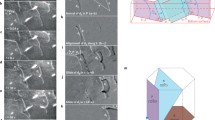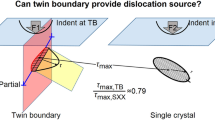Abstract
The effects of elastic anisotropy on the energy and thermodynamic stability of dislocations in β-tin and lead were assessed through computation of the dislocation energy factorK. The energy factors were utilized to construct an inverse Wulff plot, from which unstable dislocation orientations are defined by concave regions of the construction. Dislocation instabilities are predicted for β-tin near the melting point for four of six slip systems considered, the slip systems displaying the instabilities being (110) [001], (100) [001], (010) [101], and (101)[101]. An instability is predicted also for the slip system {111} <111> in lead, which is the first fcc metal found to display sufficient elastic anisotropy for instability. For the metals examined in this paper, the angular range over which instabilities occur narrows with decreasing temperature, and usually, below some critical temperature, the dislocation line becomes stable over all orientations. The occurrence of dislocation instabilities is a direct result of elastic anisotropy, and their possible influence on physical properties is discussed.
Similar content being viewed by others
References
G.de Wit and J. S. Koehler:Phys. Rev., 1959, vol. 116, pp. 1113–20.
W. W. Mullins: chapter inMetal Surfaces: Structure, Energetics and Kinetics, p. 17, American Society for Metals, Metals Park, Ohio, 1963.
A. K. Head:Phys. Status Solidi, 1967, vol. 19, pp. 185–92.
F. C. Frank: chapter inMetal Surfaces: Structure, Energetics and Kinetics, p. 1, American Society for Metals, Metals Park, Ohio, 1963.
A. K. Head, M. H. Loretto, and P. Humble:Phys. Status Solidi, 1967, vol. 20, pp. 505–19.
A. K. Head, M. H. Loretto, and P. Humble:Phys. Status Solidi, 1967, vol. 20, pp. 521–36.
E. S. Fisher and L. C. R. Alfred:Trans. TMS-AIME, 1968, vol. 242, pp. 1575–86.
J. L. Routbort, C. N. Reid, E. S. Fisher, and D. J. Dever:Acta Met., 1971, vol. 19, pp. 1307–16.
R. A. Masumura, C. L. Vold, and M. E. Glicksman:Scripta Met., 1972, vol. 6, pp. 607–10.
Y. T. Chou and G. T. Sha:Phys. Status Solidi (a), 1971, vol. 6, pp. 505–13.
M. H. Loretto and R. J. Wasilewski:Phil. Mag., 1971, vol. 24, pp. 1311–28.
Y. Lii and C. S. Hartley:Met. Trans., 1972, vol. 3, pp. 2115–18.
E. W. Kammer, L. C. Cardinal, C. L. Vold, and M. E. Glicksman:J. Phys. Chem. Solids, 1972, vol. 33, pp. 1891–98.
E. W. Kammer: Naval Research Laboratory, Washington, D. C, unpublished research, 1971.
J. A. Rayne and B. S. Chandrasekhar:Phys. Rev., 1960, vol. 120, pp. 1658–63.
D. L. Waldorf and G. A. Alers:J. Appl. Phys., 1962, vol. 33, pp. 3266–69.
J. D. Eshelby, W. T. Read, and W. Shockley:Acta Met., 1953, vol. 1, pp. 251–59.
A. N. Stroh:Phil. Mag., 1958, vol. 3, pp. 625–46.
A. J. E. Foreman:Acta Met., 1955, vol. 3, pp. 322–30.
J. P. Hirth and J. Lothe:Theory of Dislocations, p. 419, McGraw-Hill, New York, 1968.
A. K. Head:Phys. Status Solidi, 1964, vol. 6, pp. 461–65.
L. K. France, C. S. Hartley, and C. N. Reid:Metal Sci. J., 1967, vol. 1, pp. 65–70.
J. Friedel:Dislocations, p. 458, Pergamon Press, Oxford, 1964.
A. K. Head:Phys. Rev. Letters, 1967, vol. 18, pp. 484–85.
K. Ishii:J. Phys. Soc. Japan, 1970, vol. 28, pp. 168–76.
K. Ishii:J. Phys. Soc. Japan, 1970, vol. 28, pp. 1494–99.
J. D. Eshelby:Phil. Mag., 1949, vol. 40, pp. 903–12.
C. N. Reid:Acta Met., 1966, vol. 14, pp. 13–16.
N. S. Brar and W. R. Tyson:Can. J. Phys., 1972, vol. 50, pp. 2257–64.
M. H. Yoo and C. T. Wei:J. Appl. Phys., 1967, vol. 38, pp. 4317–22.
A. Ball and R. E. Smallman:Acta Met., 1966, vol. 14, pp. 1517–26.
W. K. Burton, N. Cabrera, and F. C. Frank:Phil. Trans. Roy. Soc., 1951, vol. 243A, pp. 351–54.
Author information
Authors and Affiliations
Rights and permissions
About this article
Cite this article
Vold, C.L., Masumura, R.A. & Glicksman, M.E. The influence of elastic anisotropy on dislocation stability in /gb-tin and lead. Metall Trans 5, 135–141 (1974). https://doi.org/10.1007/BF02642937
Received:
Published:
Issue Date:
DOI: https://doi.org/10.1007/BF02642937




